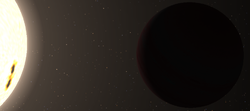| Observation data Epoch J2000.0 Equinox J2000.0 | |
|---|---|
| Constellation | Phoenix [1] |
| Right ascension | 23h 34m 15.0857s [2] |
| Declination | −42° 03′ 41.048″ [2] |
| Apparent magnitude (V) | 12.468±0.025 [3] |
| Characteristics | |
| Evolutionary stage | Main sequence |
| Spectral type | G7V [4] |
| Apparent magnitude (V) | 12.468±0.025 [3] |
| Apparent magnitude (B) | 13.216±0.020 [3] |
| Variable type | Planetary transit variable [4] |
| Astrometry | |
| Radial velocity (Rv) | 57.61±0.76 [2] km/s |
| Proper motion (μ) | RA: 9.950(12) mas/yr [2] Dec.: −87.620(10) mas/yr [2] |
| Parallax (π) | 3.6623±0.0147 mas [2] |
| Distance | 891 ± 4 ly (273 ± 1 pc) |
| Details | |
| Mass | 0.899+0.033 −0.031 [5] M☉ |
| Radius | 0.9150+0.0089 −0.0091 [5] R☉ |
| Surface gravity (log g) | 4.472+0.013 −0.012 [5] cgs |
| Temperature | 5488+29 −28 [5] K |
| Metallicity [Fe/H] | −0.050±0.040 [6] dex |
| Rotation | 22.2±3.3 [6] days |
| Rotational velocity (v sin i) | 2.2+0.6 −1.0 [6] km/s |
| Age | 7.0±2.9 [6] Gyr |
| Other designations | |
| 1SWASP J233415.06-420341.1, TOI-232, TIC 402026209, WASP-4, TYC 8017-108-1, 2MASS J23341508-4203411 [7] | |
| Database references | |
| SIMBAD | data |
| Exoplanet Archive | data |
WASP-4 is a G-type main-sequence star approximately 891 light-years away in the constellation of Phoenix. [4] [1] [2] Despite its advanced age, the star is rotating rapidly, being spun up by the tides raised by a giant planet on a close orbit. [8]
